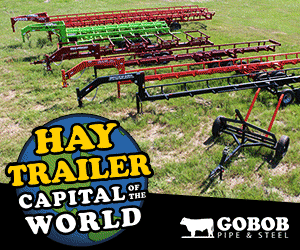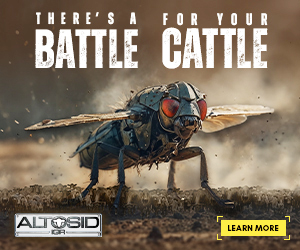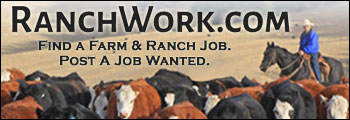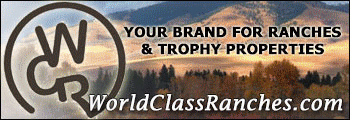Jordan Thomas, Ph.D., State Cow-Calf Extension Specialist - University of Missouri
Cows are weird creatures. Years ago during a synchronization and AI field trial, we had several hundred heifers in a drylot facility that was anything but “dry.” Every animal came through the chute with mud caked onto its ear tag, which sure slows down a research trial. To identify every animal correctly, we scrubbed and cleaned every tag. But a really wild thing happened when we got the heifers up the morning of AI: every single heifer in the group now had a mutilated, illegible ear tag. What in the world had happened in the three days since we’d handled them last?
Luckily, the heifers had metal clip OCV tags somewhere under all the mud. We were able to sort it out again, this time by cleaning the mud from every single heifer’s little metal tag. Every single heifer except one, I should say. One of the last heifers to come through the chute stuck out like a sore thumb with her pristine, untouched tag. That was our culprit. Why she had to chew up every single other heifer’s tag, we will never know. Cows are weird creatures. But you know what? We are weird creatures too—perhaps weirder than we realize.
The Endowment Effect
In his fascinating book Thinking Fast and Slow, psychologist Daniel Kahneman describes several experiments from his extensive research career. A couple experiments stuck out to me as being particularly relevant to us in the cattle business. In the design of one experiment, some participants were given a coffee mug, and some participants were given a small amount of money with which to potentially buy the mug from the other participants. Dr. Kahneman and his colleagues were interested in how each group would price the items. Essentially, the “sellers” were asked what dollar amount it would take for them to sell their mug, and the “buyers” were asked what dollar amount they would be willing to pay for a mug. A third group of participants, “choosers,” were not given either cash or a mug. Instead, “choosers” were asked to examine a mug and decide at what dollar amount they would choose to receive it rather than receive the same dollar amount as cash. What do you think happened?
The “buyers” were willing to give an average of $3 for a mug. Interestingly, the “sellers” wanted an average of about $6 to part with the mugs they had been given. Even more interestingly, the “choosers” valued the mug at $3. Now, think through this for a moment. Both the “sellers” and “choosers” actually faced the same choice. Either will leave with a mug or leave with an amount of money they did not have before. The only thing that was different between a “chooser” and a “seller” is whether they perceived the mug as already belonging to them. Simply by having had the mug placed in their hands at the start of the experiment, the “sellers” valued the mug artificially higher than they otherwise would have. The psychological term used to describe this phenomenon is the “endowment effect.”
The Status Quo Bias
A similar phenomenon described by Dr. Kahneman is the “status quo bias.” For an illustration of this bias, consider the following question. Would pay off a home mortgage if a mysterious benefactor chose you at random and happened to give you just enough money to pay off the mortgage? Many people asked this question say they would not, because other financial priorities or other more lucrative ways to invest the money come to mind. Now consider this question: if a mysterious benefactor randomly paid off your home, would you go take out a loan against your home for the same amount of money? For the sake of argument, assume it’s the same interest rate in either case. Usually, very few people asked this question are willing to take out a loan against their newly paid-for home.
From a balance sheet perspective, however, both decisions are identical. Taking out a loan against a paid-for home also frees up cash for other financial priorities or more lucrative investments. But if you ask large numbers of people this question, you will find the status quo bias has a strong effect. People perceive risk differently and therefore might act differently depending on the reference point or the status quo.
Keep vs. Cull Decisions
How is the relevant to beef cattle? Well, the cattle business is inherently an asset-based business. Land is an asset. Cattle are assets. Equipment and facilities are assets. Most of these are assets we think we will own for a long time. If you believe the research on the endowment effect and the status quo bias, we should expect ourselves to have some irrational tendencies. We are likely going to be less willing to sell an asset than we ought to be. If we don’t sit down and make sober financial assessments about whether we continue to own something, our human nature will cause us to make the wrong decision at least some of the time.
Consider this: by not selling a cow, we are in effect choosing to buy her again. From a balance sheet perspective, not selling a lower-productivity cow is actually the exact same decision as buying her again for whatever she is worth today. It doesn’t feel like the same decision, because we already have the animal on the farm. However, both decisions are identical in their end result on the balance sheet. In the end, we either have the lower-productivity cow on the balance sheet, or we have the liquidity freed up for another investment. That is because economics is one thing, but behavioral economics is another. The decisions, although identical, feel different.
Enterprise Accounting
We encounter the same thing when we choose to hold onto cull cows in order to add value to them. For example, we may try to add condition to them, catch a better cull cow market, or give them another chance at breeding in order to market them as breds rather than opens. As a fan of enterprise accounting, I like to think of these attempts to add value to cull cows as being its own “cull cow upgrading” enterprise. Depending on the numbers, it may appear profitable to add value to cull cows. But an important question often goes unasked: is that the most profitable enterprise to invest in? Those cows represent equity that will remain tied up in instead of becoming liquidity that could be used in other enterprises. That is not to mention that the cull cow upgrading enterprise will eat up—literally—resources that could have been used in a different enterprise.
When considered this way, we often find a cull cow upgrading enterprise is a distraction and a relatively low return-on-equity enterprise. The numbers may indicate we should simply focus on highly productive cows in the cow-calf enterprise. Alternatively, we may find opportunities to add or expand more profitable enterprises related to growing classes of cattle (stockers, heifer development, etc).
We have to ask the question in a way that takes away bias: if we didn’t already own those open cows, would we actually go purchase them just to try to add value to them? Enterprise accounting makes this type of question the default. It forces us to act like ownership is changing hands from one enterprise to another. If we demand that the “cull cow upgrading” enterprise essentially purchases cull cows at fair market price from the cow-calf enterprise, we force ourselves to be honest about how much margin we have in continuing to own them. Of course, the same considerations apply when deciding to retain and develop heifer calves as potential replacements, or when considering retaining ownership of calves post-weaning.
We human beings are not nearly as rational of creatures as we think we are. Luckily, we have a unique ability to sit down with a set of numbers and “think slow.” A big part of becoming successful in the cattle business—and in any business, for that matter—is just making ourselves do it.
Source: University of Missouri

